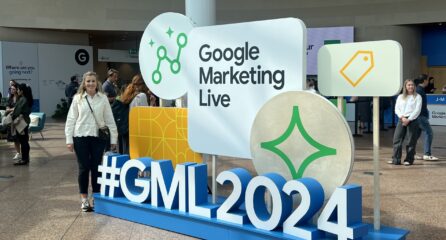Think of Dublin and which word beginning with G springs to mind? If it was Guinness, rest assured that it was involved in the trip, but it was Google that brought the Loom Paid Media team to the city.
Our Paid Media team visited the Google offices for an Immersion Day with their strategic team to learn about recent Google advancements and how to achieve the best results for our clients. Read on to find out what they learned.
Our key takeaways from Dublin
The team was primed for a full day of learning to ensure we’re making the most of Google’s suite of products. They got to hear from the search giant directly about what’s on the horizon for biddable media and how we can use the latest products and campaigns to take our clients’ paid strategies to the next level.
Here’s what they took away from the day:
Get on top of consent mode
If you work in the industry, you’ll know that we’re all buzzing about Consent Mode. This is because the deadline for setting up the latest version, Consent Mode V2, passed in March 2024. If you don’t comply with the latest guidelines, you’re unable to run ads in the EEA.
Essentially, consent mode affects how sites store and use user data based on their preferences. Google then uses these preferences to model conversions and user behaviour on your site in Ads and Analytics. V2 is the updated version, designed to ensure you – and search engines – are meeting GDPR requirements.
At Loom, Consent Mode has been a top priority, making sure that our clients are compliant with the legislation.
“Consent Mode Version 2 from the users’ perspective is seeing a cookie banner on entry then being allowed to customise which cookies they opt into. From the advertisers’ perspective, Consent Mode V2 will mean you can get more conversions reported from people who have rejected Analytics and Advertiser cookies. It does this by modelling conversions made by people who reject cookies, which aids the Google algorithm – restoring data lost by not using it. If V2 isn’t set up, then you are at risk of Google Analytics not showing data from countries in the EEA. This will affect the UK, too, so it’s worth starting ASAP.”
Alex Instone
With such a change sending tremors through the industry, it’s no wonder that this topic was the key takeaway from our Dublin trip:
“Measurement was the key talking point. Businesses must get this right and ensure that lead-generation sites are configured for consent. You’ll need to sync up with offline data sources like customer relationship management (CRM) systems, where you can find information like contact and loyalty scheme data, to ensure you have the most reliable and accurate data moving forward.”
Sam Gosling
Key takeaway:
Get on top of consent mode as soon as you can. There are a number of Google-approved partner cookie management platforms available to help create a smooth setup.
If you’re struggling with implementation, or are unsure which platform is right for you, we have plenty of experience working with businesses to get set up quickly and easily. Speak to our team for more information.
Utilising video throughout your campaigns
Short-term videos are becoming a key tool for advertisers, quickly capturing users’ attention and encouraging engagement. And with Google continually promoting video over image ads, there are now a range of new campaigns and features being rolled out.
One example is Demand Gen. These campaigns are powered by AI and take your best-performing assets for display and video across YouTube Shorts, Discover and Gmail. Users will then be presented with enticing ads that help increase conversions.
“Youtube Shorts was pitched as a big potential for Google advertisers. With the rise of short attention-grabbing content platforms like TikTok, Google’s Youtube Shorts is integrated within Google’s advertising ecosystem allowing advertisers to start serving creatives in these placements with ease.”
Dan Waller
“Short form video content is becoming more and more powerful and relevant in today’s ads. AI campaigns are improving year on year, and are slowly becoming some of the most powerful campaigns available. Demand Gen helps advertisers to drive action across YouTube, YouTube Shorts, Discover and Gmail. Advertisers who run image and video ads with Demand Gen campaigns deliver +6% conversions per dollar than those running image-only ads in Discovery campaigns.”
Harry Pearson
“Traditional display is making way for video ads to steal the show – with new placements such as Youtube Shorts or auto-generated videos (available in Performance Max and Demand Gen), expect to see more opportunities to create free video content quickly from still imagery in the future.”
Dan Waller
Key takeaways:
- Consider adding video to your biddable media strategy – test various formats and campaigns to see what performs well, making the most of the free tools currently available.
- Start trialling Demand Gen campaigns and see how these ads perform across the Google suite.
Introducing Product Studio
Demand Gen isn’t the only AI-powered tool now in advertisers’ arsenals. Product Studio is another tool that will soon be rolling out and taking your assets to another level.
Currently in open beta, you can generate lifestyle images and improve resolution within Merchant Centre, ensuring they’re better suited to your campaigns. Essentially, you produce images that are more relevant and of higher quality in no time, ensuring that your ads are attractive to target audiences.
Alongside this, more generative AI will roll out on both responsive search ads and responsive display ads. This AI will suggest headlines and descriptions that are super relevant to target audiences and help you build large sets of ads quickly and easily.
“Google are finally giving us a way to easily edit product images within the feed, using AI to create unique and tailored imagery for free – reducing time and cost of visual creation. With better images we should see an improvement overall performance and business growth.”
Romy Gwilym
Key takeaways:
- Test Google’s latest tools and features and begin harnessing the power of AI to increase efficiency.
- High-quality creative is what draws users in. Spend more time choosing imagery that best suits your campaigns, utilising Product Studio to enhance them further.
Nail search campaigns before using Performance Max
Performance Max (PMAX) provides a great opportunity for advertisers looking to maximise their conversions. It serves every channel in Google’s ad inventory and uses machine learning and AI to choose the best combination of assets and increase leads and conversions by optimising budgets and bids. As it works on every Google Ad channel, Performance Max can help your current marketing mix see even more incremental conversions and better long-term results.
Good creative, both visual and ad copy, is the basis for a successful Performance Max campaign. It can be used as a tool for all stages of the funnel but it should be viewed as one part of a healthy marketing strategy. Before you start with a Pmax campaign, make sure that your search campaigns are effective – they should be enhanced by Performance Max, not pushed into the dark.
As PMax isn’t keyword-based and is, instead, automated, it can be harder to control where your ads are seen. This is why search campaigns that use relevant keywords should still be your focus, with PMax being secondary. Read our Performance Max blog for more guidance.
“Google’s AI product, Gemini, can already be found in Performance Max through the integration of generative AI tools which allows easier ways of campaign creation, by streamlining ad copy and visual asset creation tools, making it easier than ever to implement Performance Max into your current marketing mix.”
Daniel Walpole
Key takeaway:
Performance Max can maximise conversions, but you should ensure your search campaigns are performing first. PMax is meant to complement your other campaigns rather than be the sole driver of conversions.
Humans have never been more important
According to a study run by Google and Storyline Strategies, 66% of users seek personalised brand experiences. This is where Gemini, Google’s most capable AI model, can help marketers build better search campaigns.
Generative AI can help you reach target audiences and craft tailored ad formats while also increasing efficiency. As we’ve discussed, tools like Product Studio can help advertisers enhance their visuals, but there are even more products and campaigns available that depend on AI. Dream Screen is another tool we’ve yet to mention, which enhances the background of YouTube Shorts videos using AI-generated media.
However, while AI has helped elevate the creative process, human skills like strategy and creativity have become even more important when optimising campaigns and generating targeted content.
It’s also crucial to remember that AI is only as good as the data you put into it. Businesses must ensure they preserve their measurement data, so AI can truly show its power when running paid campaigns.
“While AI is here and is certainly changing the online advertising landscape, human skills, particularly in strategy and creativity, are not being replaced but are becoming increasingly vital.”
Tamas Mihaly
Key takeaways:
- While utilising AI throughout your campaigns, your data analysis skills will also be key. You’ll need to be able to interpret the insights provided by AI tools to leverage them effectively.
- Remember to not let AI do all the work. We’ve already mentioned the importance of creativity and strategy. While the current features and products available to you will enhance your campaigns, none of them will really understand target audiences like you do or create copy that is 100% perfect. AI is there to enhance what you can already do.
Looking to the future
Growth will be a primary goal for brands in 2024 and beyond. There will be many opportunities to adapt, experiment and drive profitable growth through Paid Media, especially with the range of features and products we’ve mentioned that are rolling out.
The four key areas to focus on for a future-proofed paid media strategy are:
- Setting truly realistic KPIs and understanding how they will impact your bottom line.
- Be transparent and clear about how user data is utilised across the suite of products you use and how it informs your AI tools.
- When turning to AI, remember it’s the combination of human input and technology that’s powering this new age of creativity.
- Invest in your value measurement strategy. Make sure you’re deploying all the current solutions available and keeping up-to-date with the ever-changing digital landscape.
Key takeaways:
- A key takeaway from the event was that getting privacy rights is essential. Strong privacy fundamentals enable more accurate measurement and help build user trust.
- Keep in mind legal and brand compliance when using AI. Data privacy risks have been a cited concern for businesses, so be mindful of the data you’re inputting.
Google & Loom – Premier Partners
Our paid media team are back and raring to go. As Tommy Pearson said:
“Google have always been a close partner to us as an agency, giving us next-level insights and access to new features, and training the team up whenever new products are released. Our trip to Dublin showed just how close a partner we are to them, giving us the time and access to their team to make sure we’re delivering market-leading Paid Media management in 2024. The team are prepped with loads of new things to try on their client accounts and kick performance on this year. Our Google Premier Partner status as an agency is as important as ever, and days like this ensure we deliver marketing-leading Paid Media management for our clients in 2024.”
Tommy Pearson
As a Premier Partner, you can depend on Loom to manage your paid media. Find out how our Paid Media team can help you achieve your goals by dropping us a line at [email protected], calling 0117 923 2021, or filling out the enquiry form here.





